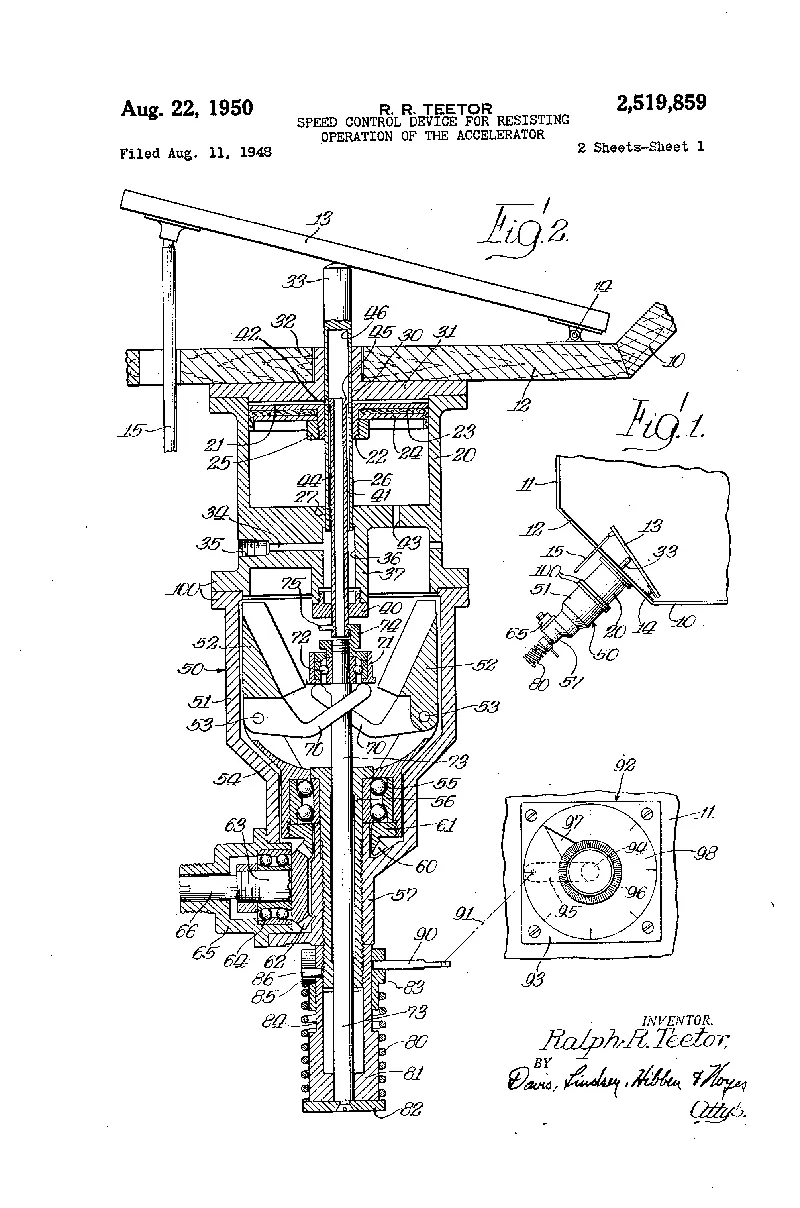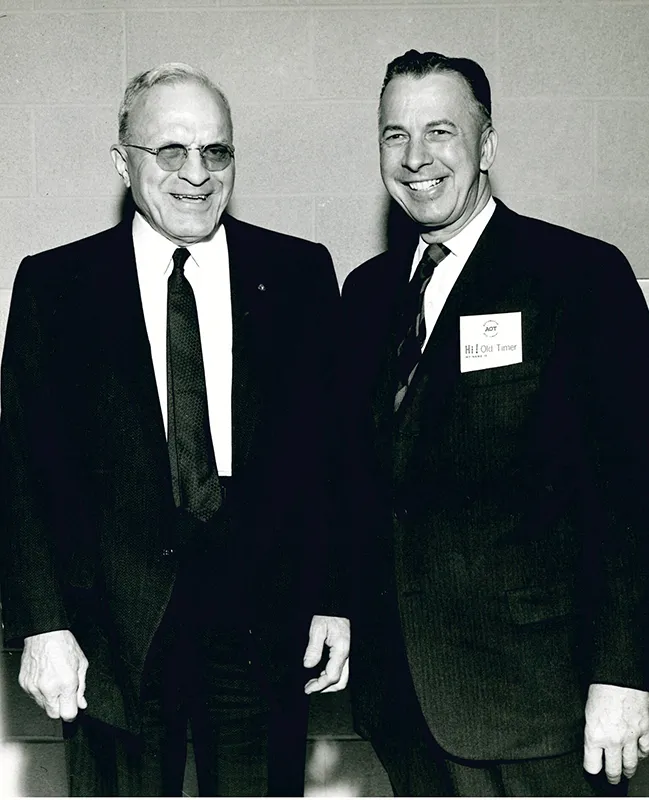The Sightless Visionary Who Invented Cruise Control
Self-driving cars were far from Ralph Teetor’s mind when he patented his speed control device
/https://tf-cmsv2-smithsonianmag-media.s3.amazonaws.com/filer/24/93/24933abe-cdef-4078-972f-51718ebf8997/ralph-teetor-and-cruise-control.jpg)
In late 2011, Steve Mahan, executive director of California’s Santa Clara Valley Blind Center, who is legally blind, told Google engineers he’d “like to be the first unlicensed driver to get behind the wheel” of the self-driving vehicle then under development by the company. In October 2015, Mahan got his chance. From the “driver’s seat” of a Firefly, a Google prototype vehicle devoid of steering wheel and foot pedals, he negotiated the streets of Austin, Texas. What was soloing like? “Just perfectly normal,” says Mahan, who drove for 35 years until sight impairment forced him to surrender his driver’s license. “The automated system drives the way that you were taught to drive.”
While experts caution that fully autonomous driving—automobiles operating safely without any direct human intervention—is at least a generation away, its eventual beneficiaries will have a pioneering and completely sightless inventor named Ralph Teetor to thank. Cruise control, Teetor’s 1950s electro-mechanical device that partially automated driving speed, paved the way for more recent digital technologies like GPS driving directions, hazard anticipatory breaking and active lane control.
Childhood misfortune rudely thrust Teetor into the challenges of everyday navigation. Born in 1890 in Hagerstown, Indiana, Teetor grew up amidst a constellation of family-owned manufacturing businesses that adapted and evolved from building bicycles to automobile engines. When he was just five, Teetor accidentally blinded one eye while playing with a knife. Within a year, sympathetic opthalmia, a condition in which trauma to one eye induces damage to the other, rendered him completely blind.
Teetor, however, quickly honed compensatory skills. “His sense of touch was legendary,” wrote his daughter Marjorie Teetor Meyer in a 1995 biography. “His hands were his eyes,” recalls Ralph Meyer, his namesake grandson. “On Christmas mornings, I’d bring my favorite toy over and let him ‘see it.’”
As Meyer explained it, his grandfather learned to perambulate Hagerstown on his own, sensing building corners by the subtle echo of his metal-tipped shoes, for example, or counting steps between known landmarks. He could even avoid turn-of-the century traffic hazards. “He could smell the horses coming. And the very first cars were not quiet,” he adds.
Encouraged by family, Teetor routinely broke barriers. “After high school,” notes Bill Hammack, a chemical and biomolecular engineering professor who has studied Teetor’s knack for innovation, “he decided to become an engineer in an era when many colleges refused to even consider his application.” Because Teetor’s cousin Neva Deardorff was an economics graduate student at the University of Pennsylvania, he personally convinced Penn’s engineering dean to admit him to the school’s mechanical engineering program. Ralph needed little more than Neva’s assistance in reading textbooks and written assignments. “Successful engineers think in images,” says Hammack. “Their minds occupy a nonverbal world, not easily reducible to words. Ralph Teetor had this kind of thinking in spades.”
Following graduation, Teetor eventually returned home, but not before devising a breakthrough process for dynamically balancing steam turbines on U.S. Navy warships. When his father and three uncles opted to specialize in piston ring production under the Perfect Circle brand, Ralph became the company’s lead engineer—and eventually its president. Because better piston rings meant more efficient and powerful engines, Perfect Circle piston rings soon became standard.
Family lore holds that the jerky accelerator foot of Harry Lindsay, Teetor’s patent attorney, friend and frequent chauffeur, originally inspired cruise control. More likely, there were other influences. During World War II, for example, the U.S. imposed a nationwide 35 mph speed limit to save gas and tire rubber. Moreover, as grandson Meyer explains: “As president of the Society of Automotive Engineers (SAE) [he gave] speeches themed around automobile safety. Speeds had gotten high enough that highway accidents were catastrophic. Safety consciousness played as big a role…as the variability of the drivers that drove for him.”
Teetor envisioned a speed mechanism controlled by the motorist. Upon reaching a dialed-in speed, the motorist’s foot would feel resisting pressure from the accelerator as a warning. Holding the pedal steady would enable the motorist to maintain dialed-in speed, pressing down would deliver acceleration.
The first “Speedostat” prototype—what company insiders called the “Stat”—comprised a dashboard speed selector connected to an engine compartment mechanism running off the drive shaft. As driver-set speed neared, the governor mechanism overcame spring tension to activate a vacuum-driven piston capable of pushing back against the gas pedal. Teetor received a patent for the speed control device on August 22, 1950. During early tests, says Meyer, as a driver steered a test vehicle, Teetor sprawled across its floor, hand on the gas pedal.

The first good Stat working model, which emerged in 1949, lacked a “speed lock”—a means to automatically sustain dialed-in speed. “He was very concerned that people would fall asleep at the wheel,” says Meyer.
Five years later, Popular Mechanics described Speedostat as “a kind of power-operated accelerator, or governor with extras. It definitely takes us several miles farther down the road to automatic pilots for cars.” As Teetor lobbied automotive manufacturers to adopt Stat as factory install, he eventually added the speed lock capability: an electro-magnetic motor maintained dialed-in speed until the driver tapped the brake pedal.
In 1958, Chrysler was first to offer Speedostat as a luxury model option. A year later, its popularity influenced Chrysler to offer Speedostat on all car models. Next came General Motors’ Cadillac Division, which re-christened and marketed the device as “Cruise Control.” Over the next decade, Cruise Control continued as a convenient, though not essential, feature. All that changed dramatically in 1973, when the Organization of Petroleum Exporting Countries (OPEC) imposed an embargo against the United States. Teetor’s remarkable innovation emerged as a widely-accepted, gas-conserving motorist tool. Studies at the time showed that the national speed limit prompted by the oil embargo saved 167,000 barrels of oil a day.

The oil embargo found Ralph Teetor, in retirement, having sold Perfect Circle to Toledo, Ohio’s Dana Corporation in 1963, but continuing to work in his private workshop, a one-story, city block-long glass and brick building in Hagerstown. Sadly, however, just as Cruise Control was coming into its own, arthritis was progressively crippling Teetor’s “seeing hands.” He died in 1982 and was inducted into the Automotive Hall of Fame six years later.
When prompted to reflect how Teetor might react to the latest autonomous driving advances, Meyer says, “I still marvel at his invention, but he didn’t invent Cruise Control with the idea that somebody wouldn’t be driving. His was an analog time and now we’re in a digital world.”
A Perfect Circle colleague once asked his grandfather how much more might have been accomplished had he been able to see. “I probably couldn’t have done as much,” Teetor reflected. “I can concentrate, and you can’t.” His grandson says, “There was a purity in not being biased by his eyes.”
/https://tf-cmsv2-smithsonianmag-media.s3.amazonaws.com/accounts/headshot/David31_copy.jpg)
/https://tf-cmsv2-smithsonianmag-media.s3.amazonaws.com/accounts/headshot/David31_copy.jpg)